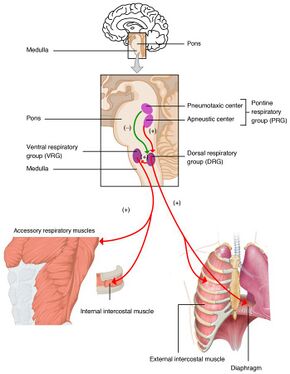Medicine:Dorsal respiratory group
| Dorsal respiratory group | |
|---|---|
 Dorsal respiratory group shown with other groups in the respiratory center | |
| Anatomical terms of neuroanatomy |
The dorsal respiratory group (DRG) is one of the respiratory groups in the respiratory centre in the brainstem. It is located in the dorsomedial region of the medulla, and is composed of cells in the solitary nucleus. The other medullar group is the ventral respiratory group. Another group in the respiratory centre is the pontine respiratory group. This is located in the pons, and is made up of the pneumotaxic centre and the apneustic centre. The DRG is found in many types of fish and mammals.[1]
Respiratory effects
The dorsal respiratory group is involved in the generation of the respiratory rhythm, and is primarily responsible for the generation of inhalation. It is also stimulated via the apneustic centre in the lower pons and is also a part of the solitary tract, which is responsible for appropriating responses to sensory information from chemoreceptors and mechanoreceptors in humans. It is inhibited by the pneumotaxic centre.
Inhalation or inspiration, begins when cells of the solitary tract nucleus (along with cells of the ventral respiratory group) [citation needed] begin a steady increase in firing, leading to contraction of the respiratory muscles. When neurons in the DRG are activated they send impulses down the phrenic and intercostal nerves to stimulate the diaphragm and external intercostal muscles. The thoracic cavity expands and air rushes into the lungs due to the negative pressure, producing inspiration. When the cells stop firing, the respiratory muscles relax, inhalation ceases, and exhalation begins.
The rhythm of the DRG produces a respiratory rate of 12–16 breaths per minute in humans. Inhalation usually lasts approximately 2 seconds, and exhalation lasts about 3 seconds. The normal respiratory rhythm is called eupnea, and difficult respiration is termed dyspnea.
See also
- Pontine respiratory group
- Ventral respiratory group
References
- ↑ Kolesnikova, EE (2011). "Role of glutamate and GABA in mechanisms underlying respiratory control". Neurophysiology (Bogomolets Institute of Physiology, Kiev, Ukraine) 42 (4): 294–304. doi:10.1007/s11062-011-9162-z.
Berne, Robert M.; Levy, Matthew N.; Koeppen, Bruce M.; Stanton, Bruce A. (2004). Physiology, 5th edition. St. Louis, MO: Elsevier. pp. 513. ISBN 0-323-03390-3.

